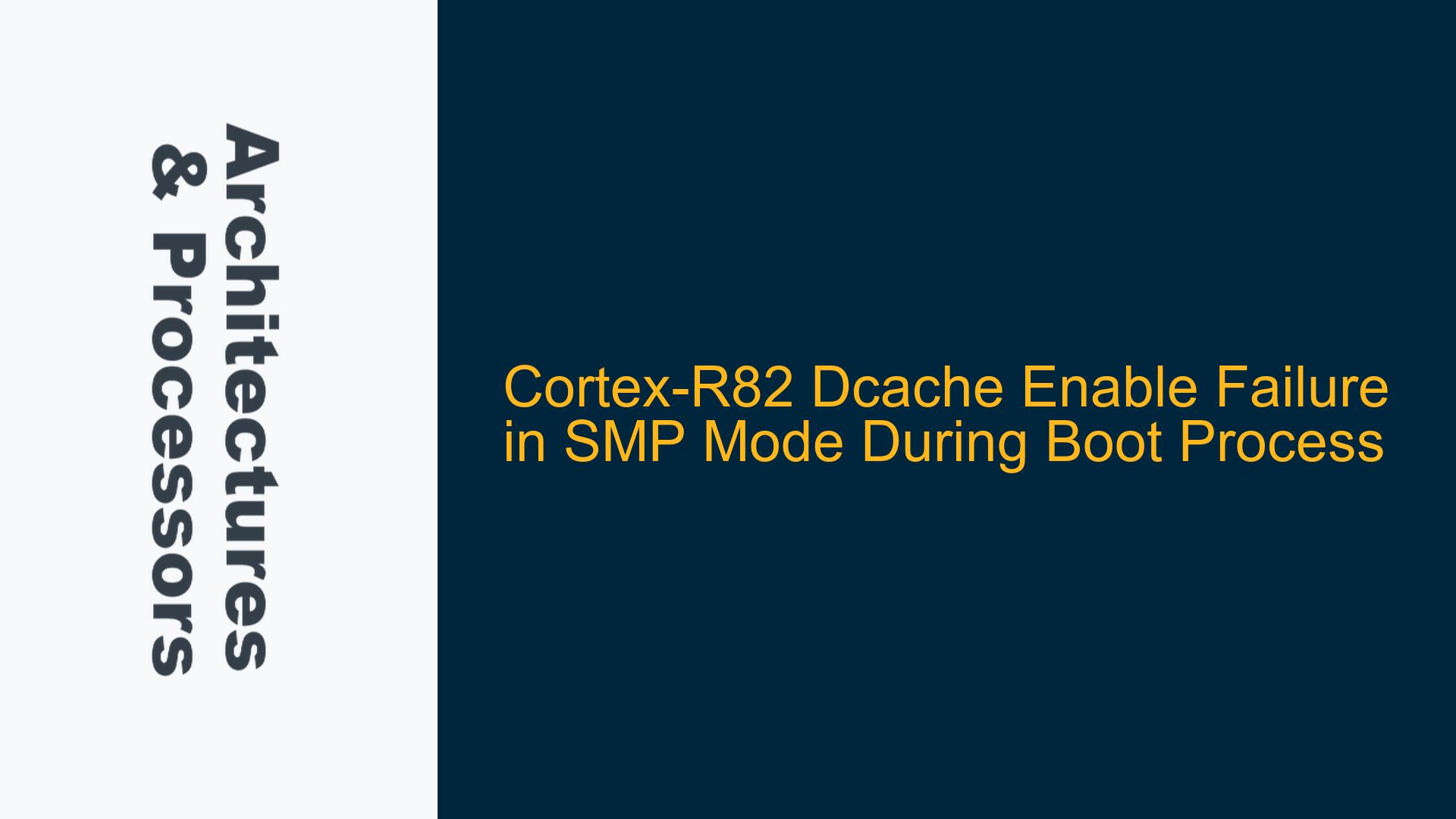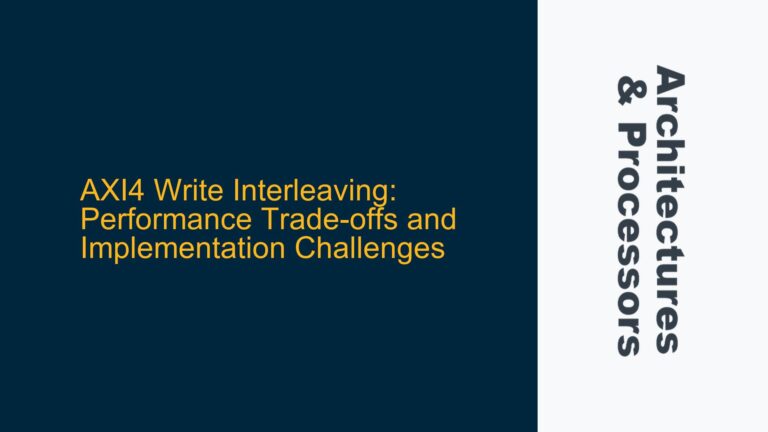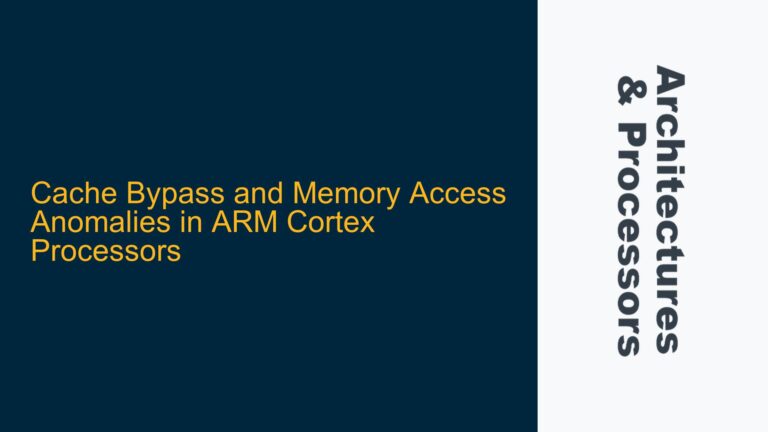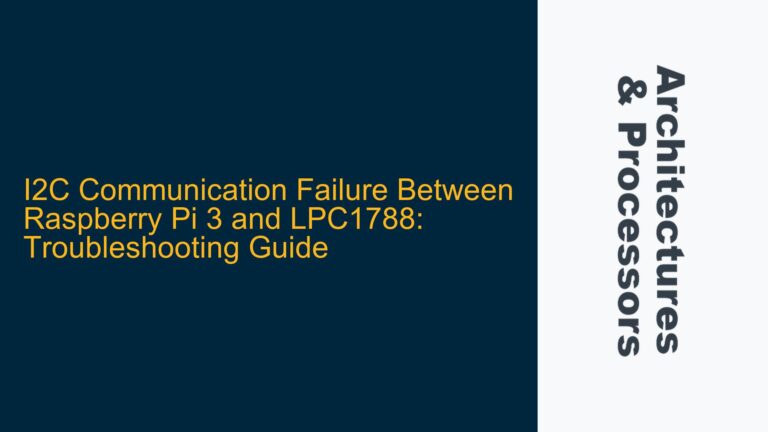Cortex-R82 Dcache Enable Failure in SMP Mode During Boot Process
The Cortex-R82 is a high-performance, real-time processor designed for applications requiring deterministic behavior and high throughput. One of its key features is the ability to operate in Symmetric Multiprocessing (SMP) mode, where multiple cores execute tasks concurrently. However, enabling the Data Cache (Dcache) in SMP mode during the boot process can lead to unexpected failures, particularly when transitioning between exception levels (ELs) and configuring the Memory Protection Unit (MPU). This issue manifests as a silent failure where the program halts without generating an explicit exception, making it challenging to diagnose.
The boot process described involves CPU0 booting from EL2, transitioning to EL1, enabling the MPU and Dcache, and then signaling other CPUs to perform similar operations. The failure occurs precisely when CPU0 attempts to enable the Dcache, suggesting a potential issue with cache coherency, MPU configuration, or exception level transitions. Given the complexity of the Cortex-R82 architecture and the interactions between its components, this problem requires a detailed analysis of the boot sequence, cache management, and SMP synchronization mechanisms.
MPU Configuration and Cache Coherency in SMP Mode
The Cortex-R82 relies on the MPU to enforce memory access permissions and attributes, which are critical for ensuring system security and stability. When the MPU is enabled, it defines regions of memory with specific access rights, cache policies, and shareability attributes. The Dcache, on the other hand, accelerates data access by storing frequently used data closer to the CPU. However, enabling the Dcache without proper MPU configuration can lead to inconsistencies, especially in SMP mode where multiple cores share the same memory space.
One possible cause of the failure is an incomplete or incorrect MPU configuration before enabling the Dcache. The MPU regions must be defined to include all memory areas accessed by the CPUs, with appropriate cacheability and shareability attributes. If the MPU regions are not correctly configured, enabling the Dcache can result in cache coherency issues, where different cores have inconsistent views of the same memory location. This can cause the system to hang or behave unpredictably.
Another potential cause is the timing of the Dcache enable operation relative to the MPU configuration. The Cortex-R82 architecture requires that the MPU be fully configured and enabled before the Dcache is turned on. If the Dcache is enabled before the MPU is properly set up, the cache may start caching data based on default or incorrect attributes, leading to coherency problems. Additionally, the transition from EL2 to EL1 involves changes to the system control registers, which must be carefully managed to avoid unintended side effects on the MPU and Dcache.
Debugging and Resolving Dcache Enable Failures
To diagnose and resolve the Dcache enable failure, a systematic approach is required, focusing on the MPU configuration, cache management, and exception level transitions. The first step is to verify the MPU configuration before enabling the Dcache. This involves checking the MPU region definitions, ensuring that all memory areas are covered, and that the cacheability and shareability attributes are correctly set. The MPU configuration should be validated using a combination of static analysis and runtime checks, such as reading back the MPU registers to confirm their values.
Next, the timing of the Dcache enable operation should be carefully reviewed. The Dcache should only be enabled after the MPU is fully configured and enabled. This can be achieved by inserting memory synchronization barriers (e.g., DSB and ISB instructions) between the MPU configuration and Dcache enable steps. These barriers ensure that all previous memory operations are completed before proceeding, preventing any race conditions or inconsistencies.
In SMP mode, additional considerations are required to ensure cache coherency across multiple cores. The Cortex-R82 implements hardware cache coherency mechanisms, but these rely on proper configuration of the shareability attributes in the MPU regions. If the shareability attributes are not correctly set, different cores may cache the same memory location without maintaining coherency, leading to data corruption or system hangs. To address this, the shareability attributes should be set to "Inner Shareable" for all memory regions accessed by multiple cores.
Finally, the exception level transitions should be carefully managed to avoid unintended side effects on the MPU and Dcache. The transition from EL2 to EL1 involves changes to the system control registers, which can affect the MPU and Dcache configuration. It is essential to ensure that these registers are correctly set before and after the transition, and that any necessary synchronization barriers are inserted to maintain consistency.
By following these steps, the Dcache enable failure in SMP mode can be systematically diagnosed and resolved. The key is to ensure proper MPU configuration, careful timing of the Dcache enable operation, and correct management of exception level transitions. With these measures in place, the Cortex-R82 can reliably enable the Dcache and operate in SMP mode without encountering unexpected failures.
Detailed Analysis of Cortex-R82 Boot Sequence and Cache Management
The Cortex-R82 boot sequence involves several critical steps that must be executed in a specific order to ensure proper system initialization. The failure to enable the Dcache in SMP mode highlights the importance of understanding the interactions between the MPU, Dcache, and exception level transitions. This section provides a detailed analysis of these interactions and offers guidance on how to avoid common pitfalls.
The boot sequence begins with CPU0 booting from EL2, the hypervisor exception level. At this stage, the system is in a privileged state, allowing full control over the hardware resources. The first task is to configure the MPU, which involves defining memory regions with specific access rights, cache policies, and shareability attributes. The MPU configuration must be carefully planned to cover all memory areas accessed by the CPUs, including code, data, and peripheral regions.
Once the MPU is configured, CPU0 transitions to EL1, the operating system exception level. This transition involves changes to the system control registers, which must be carefully managed to avoid unintended side effects. The key registers to consider are the SCTLR (System Control Register) and the HCR (Hypervisor Configuration Register). The SCTLR controls various system features, including the MPU and Dcache, while the HCR configures the hypervisor behavior.
After transitioning to EL1, CPU0 enables the MPU and Dcache. The MPU is enabled by setting the M bit in the SCTLR, while the Dcache is enabled by setting the C bit. These operations must be performed in the correct order, with the MPU enabled before the Dcache. Additionally, memory synchronization barriers (DSB and ISB) should be inserted between these operations to ensure that all previous memory operations are completed before proceeding.
Once CPU0 has successfully enabled the MPU and Dcache, it signals the other CPUs to perform similar operations. The other CPUs, which have been waiting in a low-power state, wake up and follow the same boot sequence. However, since they are operating in SMP mode, additional considerations are required to ensure cache coherency across all cores.
The Cortex-R82 implements hardware cache coherency mechanisms, such as the ACE (AXI Coherency Extensions) protocol, which allows multiple cores to share the same memory space while maintaining coherency. However, these mechanisms rely on proper configuration of the shareability attributes in the MPU regions. If the shareability attributes are not correctly set, different cores may cache the same memory location without maintaining coherency, leading to data corruption or system hangs.
To ensure cache coherency in SMP mode, the shareability attributes should be set to "Inner Shareable" for all memory regions accessed by multiple cores. This ensures that any changes to a memory location by one core are visible to all other cores, maintaining coherency across the system. Additionally, the cache maintenance operations, such as cache cleaning and invalidation, should be performed as needed to ensure that the cache contents are consistent with the main memory.
In conclusion, the Cortex-R82 boot sequence and cache management require careful attention to detail, particularly when operating in SMP mode. By following the guidelines outlined in this section, system designers can avoid common pitfalls and ensure reliable operation of the Dcache and MPU. The key is to properly configure the MPU, carefully manage the exception level transitions, and ensure cache coherency across all cores. With these measures in place, the Cortex-R82 can achieve optimal performance and reliability in SMP mode.






